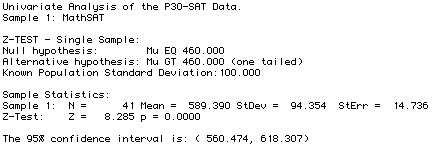Using T
The process of hypothesis testing when we don't know the population standard deviation is the same as the process when we do know it.
We have the same four steps. The only differences are in determining the critical region and in calculating the standard error.
- State the Hypotheses:
This step is the same as with the Z-Statistic.
- Set the decision criteria:
- Specify the significance level.
This is the same as with the Z-Statistic.
- Determine the critical value of T.
Here there is a new complication in using T: There isn't just one T-distribution that we use to determine the critical value of T. There is a whole family of distributions. The distribution depends on the "degrees of freedom", which is simply equal to one less than the sample size. That is:

We locate the critical T value by using the T distribution table in the Appendix.
- Gather Data
.
This step is the same as with the Z-Statistic.
- Evaluate the Null Hypothesis
.
We calculate the standard error of the mean using the sample's standard deviation. Then we calculate T and look up the P value for the obtained T and known df. Then we make a decision.
- Determine the standard error of the mean. The standard error is calculated by the formula:

- Calculate the Test-Statistic. The T formula is:

Example: Eyespot Data
Many accounts suggest that many species of animals find direct stares from another animal aversive. Some moths have developed eye-spot patterns on their wings or bodys to ward off predators. An experiment was done using 16 moth-eating birds. These birds were tested in a two-chambered box that they were free to roam in from side to side. One chamber had two eye-spot patterns painted on the wall. The other chamber had plain walls. Each bird was left in the chamber for 60 minutes, and the amount of time spent in the plain chamber was recorded.
Here are the four steps involved in the statistical hypothesis test:
- State the Hypotheses:
The null hypothesis is that there is no effect for eye-spots painted on the wall. Birds should spend half their time -- 30 minutes -- in each room. The alternative hypothesis is that there is an effect. In symbols the null and alternative hypotheses are:

- Set the decision criteria:
We arbitrarily decide on an alpha level

We also note that there are 15 degrees of freedom:

The table tells us that the critical region consists of t values less than -2.131 and greater than +2.131.
- Gather Data
:
Results:

The mean is 35 minutes in the plain side, and the sample variance is 81.
- Evaluate Null Hypothesis
:
Calculations:
The formula for the estimated standard error is:

For these data, the estimated standard error is Sqrt(81/16) = 2.25
The formulat for T is:

Thus, for these data, T = (35-30)/2.25 = 2.22
Decision:
Since 2.22 is in the critical region, we reject the null hypothesis that the presence of eye-spot patterns does not influence behavior.
- Two more ViSta examples
- Z-Test: In-class survey SAT Math and Verbal data (pop mean=460, pop stdv=100). ViSta Data
|
Report for the SAT Verbal Variable |
|---|
 |
|
Report for the SAT Math Variable |
|---|
 |
- T-Test: Newcomb Lightspeed ViSta Data
These data are from the first experiment to determine the speed of light. The best modern measurements correspond to a passage time of 33.02 in this experiment. The population standard deviation is unknown.
|
Report for the Newcomb Lightspeed Data |
|---|
 |






























